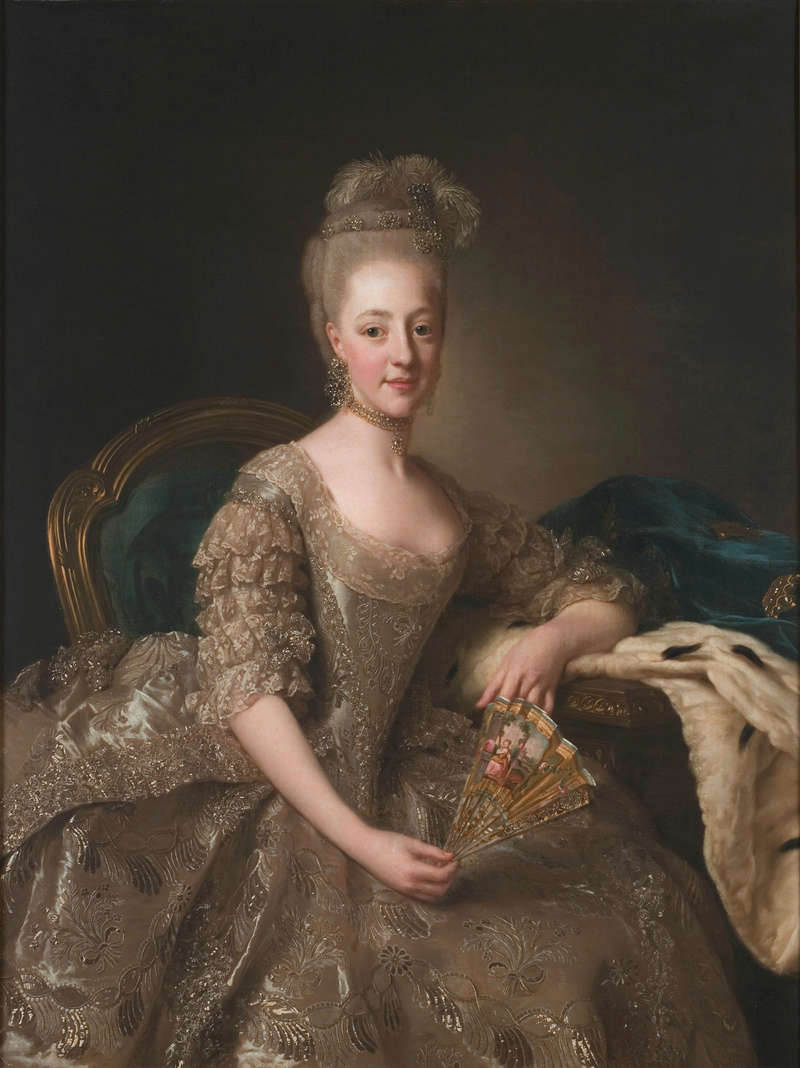- Madame de Chimay a écrit:
- Gustave III ressuscite aussi les tournois médiévaux en costumes d'époque et avec des armes aussi vraies que nature. Mais à dire vrai , ce qui pousse Fersen à participer à ces divertissements, c'est l'attrait qu'il éprouve pour la femme du duc charles, à savoir pour Hedwige Elisabeth Charlotte , princesse de Holstein Gottorp âgée de 16 ans. Cette princesse respire de joie et de bonne jumeur et cela se termine par une laison entre les deux.
https://maria-antonia.forumactif.com/t2461p255-fersen-logements-et-femmesQui est cette jolie jeune fille qui attire tous les regards, vous demandez-vous ?

La voilà !

En 1774 par Roslin
Petite bio de cette femme que nous avons la chance de connaître grâce à son journal.

Hedvig Elisabeth of Holstein-Gottorp was born 22 March 1759 in Eutin, Germany. The youngest child of the Duke of Holstein-Oldenburg and Princess Ulrike Friederike Wilhelmine of Hesse-Kassel, Hedvig Elisabeth was Queen of Sweden from 1809 until 1818, as well as Queen of Norway from 1814. At the age of 15, she married her Swedish cousin, Prince Charles, the younger brother of King Gustav III. Charles had first seen her during a visit to Eutin and was stunned by her beauty, although a marriage proposal was out of the question. Hedvig Elisabeth was only 11 years old at the time, and the Prince was in no hurry as he was busy enjoying the company of his many mistresses. However, the King and his wife had not been able to have any children, and with no heir to the throne in sight, the King began negotiating with the Eutin court. In May 1774, a delegation led by Privy Council von Fersen travelled to Wismar to bring the future Queen to Stockholm. The Council had brought her daughter Sophie von Fersen on the trip, who was around the same age as Hedvig Elisabeth and the two girls bonded immediately. Their close friendship would remain for the rest of their lives.
Inspired by the wedding of French King Louis XVI and Marie Antoinette, the court arranged a lavish celebration with a wedding ceremony in the Royal Chapel followed by theatrical performances and masquerades balls in King’s Garden. The new Duchess charmed everyone with her beauty and witty personality and became the centre of the royal court. The following words were said about the lively and flirtatious Duchess: “One can not imagine anything more lively and cheerful. She is joy itself. Her greatest pleasure is to make up jokes and foolishness. It would be a good thing, if she introduced that custom, as our by nature somewhat melancholic nation could need some cheering up”. 1
The amateur theatre was an important part of the royal court at the time, and the Duchess participated as both an actress and ballet dancer. However, after years of being criticised for “distracting” the King with her “scandalous ” dancing, she eventually retired from the stage.
In 1775, speculations of a possible pregnancy began to circulate. The rumours turned out to be false, and a disappointed Charles started seeing other women. Their relationship grew more and more distant, and Hedvig Elisabeth began having extramarital affairs. Her close friendship with Sophie von Fersen gave rise to rumours of her being bisexual, however in the many letters written to her intimate friend, the Duchess referred to Count Carl Piper as her lover 2, and she was also rumoured to be in a relationship with Count Axel von Fersen, the alleged lover of Marie Antoinette.
Around the same time, Hedvig Elisabeth began writing her now-famous diary. She initially wrote about the many scandals, gossip, and amusements of the court, but over time shifted her interests towards political matters. She also described in great detail certain people at court, including Désirée Clary, whom she claimed to be “a French woman in every inch”, as she disliked anything that wasn’t French, and consequently, “is not liked”. 3
Written in French from August 1775 until October 1817, the diary of Hedvig Elisabeth of Holstein-Gottorp covers a wide range of historical events both nationally and internationally, such as the French Revolution, the Regicide of Gustav III in 1792, and the Napoleonic Wars. Six months before her death in 1818, Hedvig Elisabeth had deposited her writings in a locked coffin which was opened a century later. It was then translated into Swedish and published in nine parts, the first one in 1902 and the last part in 1942 4, and is to this day a valuable source for Swedish historical research.
________________________________________________
Notes:&. Alma Söderhjelm (1945). Gustav III:s syskon (The siblings of Gustav III) Stockholm: Albert Bonniers Förlag. p. 28-29. 23033 (Swedish)
2. My Hellsing (2013). Hovpolitik. Hedvig Elisabeth Charlotte som politisk aktör vid det gustavianska hovet (Court Politics. Hedvig Elisabeth Charlotte as a political actor at the Gustavian court) Örebro: Örebro Universitet. ISBN 978-91-7668-964-6 page 145 (in Swedish)
3. Charlottas, Hedvig Elisabeth (1939) [1807–1811]. af Klercker, Cecilia, ed. Hedvig Elisabeth Charlottas dagbok [The diary of Hedvig Elizabeth Charlotte] (in Swedish). VIII 1807–1811. Translated by Cecilia af Klercker. Stockholm: P.A. Norstedt & Söners förlag. pp. 654–55
4. http://popularhistoria.se/artiklar/dagbok-fran-hovet
https://www.historyofroyalwomen.com/
